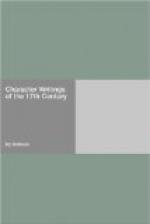Or he must fall, to sleep without his fame,
And leave a dead unprofitable name—
Finds comfort in himself and in his cause;
And, while the mortal mist is gathering, draws
His breath in confidence of Heaven’s applause:
This is the happy Warrior; this is He
That every Man in arms should wish to be.
[Footnote 1: Henry Wootton.]
[Footnote 2: “Microcosmography; or, a Piece of the World discovered; in Essays and Characters. By John Earle, D.D. of Christchurch and Merton College, Oxford and Bishop of Salisbury. A new edition, to which are add Notes and Appendix by Philip Bliss, Fellow of St. John’s College, Oxford.”]
[Footnote 3: So Washbourne, in his Divine Poems, 12mo, 1654:—
“—ere ’tis
accustom’d unto sin,
The mind white paper is,
and will admit
of any lesson you will write in
it.”—P. 26.
Shakspeare, of a child, says—
“—the hand of time
Shall draw this brief into as huge
a volume.”—K. John, II
I.]
[Footnote 4: This, and every other passage throughout the volume, [included between brackets,] does not appear in the first edition of 1628.]
[Footnote 5: Adam did not, to use the words of the old Geneva Bible, “make himself breeches,” till he knew sin: the meaning of the passage in the text is merely that, as a child advances in age, he commonly proceeds in the knowledge and commission of vice and immorality.]
[Footnote 6: St. Mary’s church was originally built by king Alfred, and annexed to the University of Oxford, for the use of the scholars, when St. Giles’s and St. Peter’s (which were till then appropriated to them,) had been ruined by the violence of the Danes. It was totally rebuilt during the reign of Henry VII., who gave forty oaks towards the materials; and is, in this day, the place of worship in which the public sermons are preached before the members of the university.]
[Footnote 7: Brachigraphy, or short-hand-writing, appears to have been much studied in our author’s time, and was probably esteemed a fashionable accomplishment. It was first introduced into this country by Peter Bales, who, in 1590, published The Writing Schoolmaster, a treatise consisting of three parts, the first “of Brachygraphie, that is, to write as fast as a man speaketh treatably, writing but one letter for a word;” the second, of Orthography; and the third of Calligraphy. Imprinted at London, by T. Orwin, &c., 1590, 4to. A second edition, “with sundry new additions,” appeared in 1597, 12mo, Imprinted at London, by George Shawe, &c. Holinshed gives the following description of one of Bales’ performances:—“The tenth of August (1575.) a rare peece of worke, and almost incredible, was brought to passe by an Englishman borne in the citie of London, named Peter Bales, who by his industrie and practise of his pen, contriued




